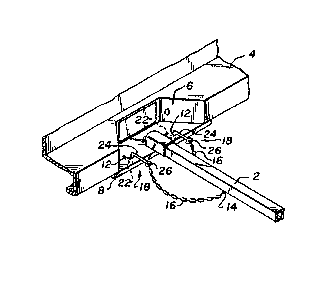Some of the information on this Web page has been provided by external sources. The Government of Canada is not responsible for the accuracy, reliability or currency of the information supplied by external sources. Users wishing to rely upon this information should consult directly with the source of the information. Content provided by external sources is not subject to official languages, privacy and accessibility requirements.
Any discrepancies in the text and image of the Claims and Abstract are due to differing posting times. Text of the Claims and Abstract are posted:
| (12) Patent: | (11) CA 1304104 |
|---|---|
| (21) Application Number: | 1304104 |
| (54) English Title: | TOW HITCH SYSTEM |
| (54) French Title: | ATTELAGE |
| Status: | Term Expired - Post Grant |
| (51) International Patent Classification (IPC): |
|
|---|---|
| (72) Inventors : |
|
| (73) Owners : |
|
| (71) Applicants : | |
| (74) Agent: | SMART & BIGGAR LP |
| (74) Associate agent: | |
| (45) Issued: | 1992-06-23 |
| (22) Filed Date: | 1987-02-06 |
| Availability of licence: | N/A |
| Dedicated to the Public: | N/A |
| (25) Language of filing: | English |
| Patent Cooperation Treaty (PCT): | No |
|---|
| (30) Application Priority Data: | None |
|---|
ABSTRACT OF THE DISCLOSURE
A tow hitch system comprising a tow bar to be
secured to a towing and to a towed vehicle. The towing
vehicle includes spaced openings adjacent to the point
where the tow bar is secured. There is an anchor point
on the tow bar. A chain received at the anchor point. A
pair of safety catches at each end of the chain engage
the spaced openings. Each safety catch comprises a
central limb to be received in an opening. Side limbs
extend from each end of the central limb to contact
opposed sides of an area of the towing vehicle adjacent
the point where the tow bar is secured to maintain the
catch in position. The system is easy to make and very
easy to use yet safe in use.
Note: Claims are shown in the official language in which they were submitted.
Note: Descriptions are shown in the official language in which they were submitted.

2024-08-01:As part of the Next Generation Patents (NGP) transition, the Canadian Patents Database (CPD) now contains a more detailed Event History, which replicates the Event Log of our new back-office solution.
Please note that "Inactive:" events refers to events no longer in use in our new back-office solution.
For a clearer understanding of the status of the application/patent presented on this page, the site Disclaimer , as well as the definitions for Patent , Event History , Maintenance Fee and Payment History should be consulted.
| Description | Date |
|---|---|
| Inactive: Expired (old Act Patent) latest possible expiry date | 2009-06-23 |
| Inactive: Entity size changed | 2002-06-10 |
| Grant by Issuance | 1992-06-23 |
There is no abandonment history.
| Fee Type | Anniversary Year | Due Date | Paid Date |
|---|---|---|---|
| MF (category 1, 5th anniv.) - small | 1997-06-23 | 1997-06-02 | |
| MF (category 1, 6th anniv.) - small | 1998-06-23 | 1998-05-26 | |
| MF (category 1, 7th anniv.) - small | 1999-06-23 | 1999-06-02 | |
| MF (category 1, 8th anniv.) - small | 2000-06-23 | 2000-04-06 | |
| MF (category 1, 9th anniv.) - small | 2001-06-25 | 2001-05-22 | |
| MF (category 1, 10th anniv.) - standard | 2002-06-24 | 2002-05-23 | |
| MF (category 1, 11th anniv.) - standard | 2003-06-23 | 2003-06-11 | |
| MF (category 1, 12th anniv.) - standard | 2004-06-23 | 2004-06-01 | |
| MF (category 1, 13th anniv.) - standard | 2005-06-23 | 2005-06-03 | |
| MF (category 1, 14th anniv.) - standard | 2006-06-23 | 2006-05-31 | |
| MF (category 1, 15th anniv.) - standard | 2007-06-25 | 2007-05-23 | |
| MF (category 1, 16th anniv.) - standard | 2008-06-23 | 2008-05-23 |
Note: Records showing the ownership history in alphabetical order.
| Current Owners on Record |
|---|
| ARTHUR LIKEI |
| Past Owners on Record |
|---|
| None |